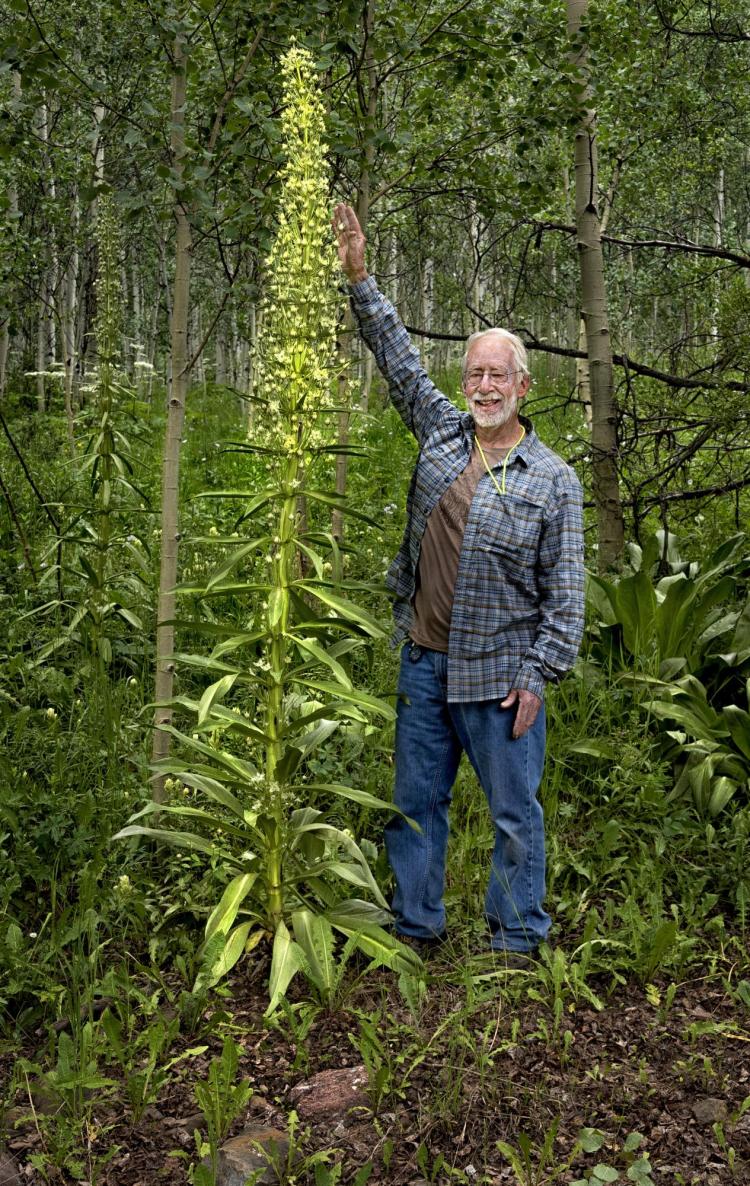Green gentians live for decades, but only flower once
Researchers' data show that this is the greatest appearance of flowering plants in the last 40 years in the Gothic townsite, near Crested Butte
This summer I have enjoyed a profusion of flowering green gentians on the Uncompahgre Plateau and also in the area around Crested Butte.
To my astonishment, many flowering stalks reach over my head. I thought I had found the tallest green gentian in Cement Creek, but David Inouye, at Rocky Mountain Biological Laboratory in Gunnison County’s Gothic, reported a green gentian slightly more than 9 feet tall in Horse Ranch Park, on the western side of Kebler Pass.

Jeff Mitton stands beside a green gentian’s flowering stalk in the Crested Butte area, pointing out its height. Photo by Gary Clendening.
Green gentian, formally Frasera speciosa (it also goes by the common name monument plant), is known for the notable habit of growing for many years as a large basal rosette and then producing a tall stalk of flowers, but only once. The plants die immediately after setting seed. Another plant known for a similar life history is the century plant, Agave americana, which typically lives one to three decades before producing a flowering stalk 25 to 30 feet tall and then dying.
Both of these plants are long-lived perennial monocarps, meaning they flower once, at the ends of their lives.
Given the size of its flowering stalks, it is not surprising that a green gentian produces a large number of seeds. An average stalk is composed of 600 flowers and is capable of producing 66,000 seeds. Dispersal of seeds is not great, so some seeds fall beneath the plant that produced them. When the plant dies, its leaves fall to the ground and decompose, fertilizing nearby seeds, doubling its germination and survival chances over the seeds that are dispersed further.
In recent columns I have attributed abundant wildflowers on the Colorado Plateau and the Chautauqua meadow to high precipitation during winter and spring, but the same cause cannot be invoked for the high numbers of flowering green gentians. Inouye, who discovered that green gentians live many decades but flower just once, also discovered that the flowers are preformed at least three years before they appear.
The plant’s commitment to flower this summer was made years ago, not during the rainy spring. Inouye’s data on flowering also show that this is the greatest appearance of flowering plants in the last 40 years in the Gothic townsite. In the nearby experimental garden, it was the fifth greatest appearance of flowering plants in the last 40 years.
Those same data can be used to show that flowering is synchronous, to some degree, for flowering is relatively high about every fourth year, but much lower in other years. Individual plants benefit substantially by flowering synchronously with many others, in comparison to those plants that flower during the off years.
Plants growing in dense stands produce about 40,000 more seeds than plants growing in the same sites, but during years when flowering plants are relatively sparse. Seed set is up to 80 percent in dense stands but around 20 percent in sparse stands, perhaps a consequence of the fact that dense stands of flowers attract more pollinators.
When a green gentian flowers, some of its offspring will flower in 20 years, while others will wait 60 or more years. Conceptually, this is puzzling, for if all other things were equal, genotypes flowering every 20 years will produce many more offspring in a century than genotypes flowering every 60 years — selection should favor genotypes that breed faster.
Apparently, all other things are not equal. Montane and subalpine environments are highly variable, with precipitation, temperature, damaging frost events, pollinator populations, germination and seedling survival varying unpredictably. It appears that, for a plant that will flower only once, having offspring flower over a period of at least 40 years is a way of hedging one’s bets in an unpredictable environment.
Inouye’s research program has revealed much about a fascinating and conspicuous wildflower, but it also demonstrates a fundamental fact in ecology. Long-term studies are necessary to identify some phenomena, such as synchronous and monocarpic flowering. For me, coordination of semi-synchronous flowering in monocarpic plants 20 to 60 years old is a marvel.

